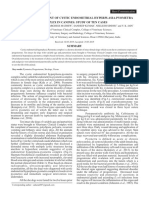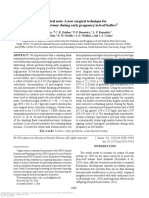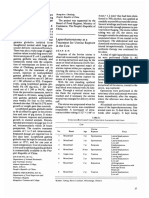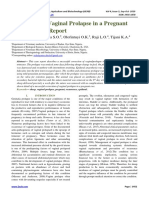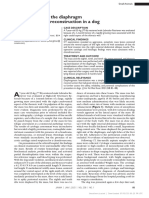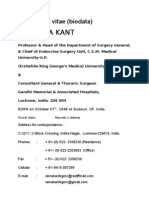Uterine Rupture
Uterine Rupture
Uploaded by
AndreaAlexandraCopyright:
Available Formats
Uterine Rupture
Uterine Rupture
Uploaded by
AndreaAlexandraCopyright
Available Formats
Share this document
Did you find this document useful?
Is this content inappropriate?
Copyright:
Available Formats
Uterine Rupture
Uterine Rupture
Uploaded by
AndreaAlexandraCopyright:
Available Formats
See discussions, stats, and author profiles for this publication at: https://www.researchgate.
net/publication/279174890
uterine rupture
Data · June 2015
CITATIONS READS
0 28
1 author:
Vijay Kumar
Riyadh Zoo Saudi Arabia
42 PUBLICATIONS 75 CITATIONS
SEE PROFILE
Some of the authors of this publication are also working on these related projects:
Monkey menace management View project
All content following this page was uploaded by Vijay Kumar on 25 June 2015.
The user has requested enhancement of the downloaded file.
R. Gogoi ef al. 141
References Kumar, M. (2003) M.V.Sc. thesis submitted to the G.B. Pant
University of Agriculture and Technology, Pantnagar,
Biswas, A.K., Rao, G.S., Kondaiah, N., Anjaneyulu, A.S.R., Uttaranchal, lndia.
Mendiratta, S.K., Prasad, R. and Malik, J.K. (2007) Joumal ot Oka, H., Matsumoto, H., Uno, K., Harada, K. 1., Kadowaki, S.
Food and Drug Analysis 15(3):278-284 and Suzuki, M. (1985) Joumalof ChromatographyA32S:265-
FAOMHO (2002\ Evaluation of certain veterinary drug 274.
residues in food. Fifty-eight meeting of the Joint FAOMHO Shahid, M.A., Siddique, M., Abubakar, M., Arshed, M.J., Asif,
Expert committee on food additives, WHO Technical Repoft M. and Ahmad, A. (2007) Asian Joumal of Poultry Science
Sen'es.911. 1(1):8-15.
lndian Vet. J., August 2012,89 (8) : 141 - 142
Laparocopic Diagnosis and Management of Uterine Rupture in a Female
Rhesus Macaque (Macacu mulatta)
Vijay Kumar
Dhauladhar Nature Park, Gopalpur, Palampur, Kangra, Himachal Pradesh 176059
(Received : 20-07 -2011 ; Accepted : 19-11-2011)
Clinical diagnosis ofuterine rupture is very rare in cage without movement. Animal was
and most of the cases remain undiagnosed anaesthesized with xylazine @ 2 mg and
(Hayes, 2004). Several etiological factors'may be ketamine @ IO mg per kg bw. On clinical
responsible for uterine rupture, which include examination no any external evidence of injury
trauma, uterine over distension, uterine was found. in the vulvar area. On per vaginal
anomalies, placenta percreta, late pregnancy, examination by vaginal spatula only blood mixed
dystocia and pyometra (Claydon, 2003). Various with mucoid was found. On physiological
authors have reported repair of uterine rupture examination there was slight increase in rectal
by various methods, either per vaginum, by temperature as well as respiration rate. Blood
everting the uterus or by laparotomy (Pascoe, samples were collected for haematological and
1968; Pearson and Denny, 1975) in various p arasitological examinations.
animals. The present communication describes
diagnosis and management of uterine rupture A decision was made to go for intra-
by laparoscopy. abdominal laparoscopic examination of the
affected animal to diagnose the cause of the
Materials and Methods vulvar bleeding.
A 16 year-old female rheusus macaque weighting After preparing surgical site pre-umbilical
about 7 kg was captured during the sterilization incision was given on ventral midline and a
programme. The animal was seen with signs of veress needle was inserted through this incision.
bleeding from vulvar area along with signs of Pneumoperitonium was achieved by carbon
dehyderation, depression, inappetance and lying dioxide with a pressure gradient of 10 mmHg.
The lndian Veterinary Journal (August, 2012)
142 Uterine rupture in a Rhesus Macaque
Fig. I Laparoscopic examination of ruptured uterus Fig. 2 Laparoscopic examination of uterine wound healing
on 3d day
Veress needle was pulled out and a trocar along lactate @ 50ml ilv and Metronidazole@ 1b mI i/v
with canula was inserted in this incision. A daily for three occasions. The animal responded,
telescope was connected to a light source inserted to the symptomatic treatment and bleeding from
through the canula. the vagina was stopped on the second day of
treatment. On repeated laparoscopy on B.d day
Results and Discussion there was initiation ofwound healing on the body
of uterus. On 5th day of laparoscopic examination
Laparoscopic examination showed a longitudinal
there was complete uterine wound healing. In
lacerated wound of about 6-8cm in diameter on
the present case there was mild peritonitis which
the midline dorsal surface of the body of uterus
recovered with antibiotics. In this case either
and blood was oozing out from the ruptured
transportation or group fighting could have been
uterus into the peritoneum cavity. HaematologSr
the possible cause ofuterine rupture. The present
revealed Hb 10.4 grdl, PCV BB o/o, TEC +.6xf06/
laparoscopic assisted technique was found useful
mm3, TLC 9.2x103mm3 and DLC N B4o/o, L6Bo/o,
in diagnosis and management of ruptured uterus
M}L%, F,02%, B0%. Haematological examination
in a female rhesus macaque.
showed anaemia with leucocytosis, while no
parasitic infestation was found.. After thorough
References
examination of ruptured uterus the decision was
rnade to keep animal on parenteral medication. Claydon, C.S and Pernoil, M.L (2003) Third{rimester vaginat
bleeding. n: DeCherney AH, Nathan L (Eds). Current Obsietric
I
Animal was given inj Enrofloxacin @ 10 mg/kg and Gynaecologic Diagnosis and Treatment, 9th ed., New
bw, Inj Meloxicam @ 0.25 mg/kg bw i/m for S days York,354.
along with inj Revici @ 0.bml, i/m for two Hayes, c. (2004) VeL Rec.134:438.
occasions and inj Tribivet O.bml, i/m for three Pascoe, R.R. (1968) Aust. Vet. J. 44: 329-330.
occasions. The supportive therapy was started Pearson, H and Denny, H.R. (1975) Vet. Rec.97:240-244.
with Dextrose solution @ 100m1, i/v Ringer,s
The lndian Veterinary Journal (August, 2012)
F View publication stats
You might also like
- Physical Activity Trainer XIDocument160 pagesPhysical Activity Trainer XIamarsharma240120% (5)
- AfiFarm 5.4 - WebDocument9 pagesAfiFarm 5.4 - WebcmukasaukNo ratings yet
- Preeclampsia Nursing Care PlanDocument8 pagesPreeclampsia Nursing Care PlanElli SuñgaNo ratings yet
- Trauma Recovery and Empowerment ModelDocument12 pagesTrauma Recovery and Empowerment Modeljimmiefking_64670597No ratings yet
- 2017 Cecal Dilatationand Distentionandits Managementinacowand Kankayam BullockDocument4 pages2017 Cecal Dilatationand Distentionandits Managementinacowand Kankayam BullockDrAmit KajalaNo ratings yet
- Unihorn Pyometra in A BitchDocument5 pagesUnihorn Pyometra in A BitchIndian Journal of Veterinary and Animal Sciences RNo ratings yet
- RJVP 5 4 40-43Document4 pagesRJVP 5 4 40-43ELYNo ratings yet
- Surgical Management of Cystic Endometrial Hyperplasia-Pyometra Complex in Canines: Study of Ten CasesDocument2 pagesSurgical Management of Cystic Endometrial Hyperplasia-Pyometra Complex in Canines: Study of Ten CasesAllison MuñizNo ratings yet
- AtresiaaniwithrectovagDocument5 pagesAtresiaaniwithrectovagAskep geaNo ratings yet
- Feline Pyometra and Its Surgical Management: A Case: Received: 30.03.2021 Accepted: 13.04.2021Document5 pagesFeline Pyometra and Its Surgical Management: A Case: Received: 30.03.2021 Accepted: 13.04.2021dewaNo ratings yet
- Atresia Ani CalfDocument5 pagesAtresia Ani CalfNancyNo ratings yet
- Surgical Management of Stump Pyometra in A Doberman Bitch-A Case ReportDocument3 pagesSurgical Management of Stump Pyometra in A Doberman Bitch-A Case Reportjakeast9No ratings yet
- Choke in A Cow - A Case ReportDocument2 pagesChoke in A Cow - A Case ReportMuhammad JameelNo ratings yet
- 9 2 131 699, Uterine TorsionDocument3 pages9 2 131 699, Uterine Torsiondr.varshini415No ratings yet
- Surgical Therapy of Complicated Uterine Stump PyomDocument6 pagesSurgical Therapy of Complicated Uterine Stump Pyomjakeast9No ratings yet
- Post Oestral Vaginal Prolapse in A Non-Pregnant Heifer (A Case Report)Document7 pagesPost Oestral Vaginal Prolapse in A Non-Pregnant Heifer (A Case Report)frankyNo ratings yet
- Pyometra StudyDocument4 pagesPyometra Studyjakeast9No ratings yet
- Vaginoscopy and Ultrasonography For Diagnosing Endometritis and Its Therapeutic Management in Repeat Breeder CowsDocument5 pagesVaginoscopy and Ultrasonography For Diagnosing Endometritis and Its Therapeutic Management in Repeat Breeder CowsGovind Narayan PurohitNo ratings yet
- Beagle Dogs PyometraDocument4 pagesBeagle Dogs Pyometrajakeast9No ratings yet
- 1 s2.0 S0093691X20303538 MainDocument11 pages1 s2.0 S0093691X20303538 MainRo BellingeriNo ratings yet
- Nueva Tec Ovh VacasDocument8 pagesNueva Tec Ovh VacasAndres Luna MendezNo ratings yet
- Ultrasonographic Diagnosis of Cystic Endometrial Hyperplasia-Pyometra in BitchesDocument2 pagesUltrasonographic Diagnosis of Cystic Endometrial Hyperplasia-Pyometra in BitchesT Deky Rizqi AmandaNo ratings yet
- Umbilical Hernia - TPIDocument4 pagesUmbilical Hernia - TPIDeepak CNo ratings yet
- Surgical Management of Atresia Ani in A Cow CalfDocument2 pagesSurgical Management of Atresia Ani in A Cow CalfGhulam zahraNo ratings yet
- Laparohysterectomy Uterine: ImmunoefficiencyDocument2 pagesLaparohysterectomy Uterine: ImmunoefficiencyAdheSeoNo ratings yet
- I J V S: Nternational Ournal of Eterinary CienceDocument3 pagesI J V S: Nternational Ournal of Eterinary CienceMarangga SarpakenakaNo ratings yet
- Asvs 03 0153Document3 pagesAsvs 03 0153Muhammad SajidNo ratings yet
- Research Article: Undescended Testes and Laparoscopy: Experience From The Developing WorldDocument6 pagesResearch Article: Undescended Testes and Laparoscopy: Experience From The Developing WorldMeliana SulistioNo ratings yet
- Surgical Management of Lipoma in A Cow: Amit Mahajan and Nikunj GuptaDocument2 pagesSurgical Management of Lipoma in A Cow: Amit Mahajan and Nikunj GuptaMalik Danish Kaleem NonariNo ratings yet
- Acquired Indirect Unilateral Chronic Reducible Scrotal Hernia inDocument7 pagesAcquired Indirect Unilateral Chronic Reducible Scrotal Hernia inaksonarain1 23No ratings yet
- Management of Oesophageal Obstruction in A DogDocument2 pagesManagement of Oesophageal Obstruction in A DogHari Krishna Nunna V VNo ratings yet
- Cystic Endometrial Hyperplasia and Pyometra in Three Captive African Hunting Dogs (Lycaon Pictus)Document7 pagesCystic Endometrial Hyperplasia and Pyometra in Three Captive African Hunting Dogs (Lycaon Pictus)Intan Renita Yulianti DrumerNo ratings yet
- Correction of Vaginal Prolapse in A Pregnant EWE: A Case ReportDocument4 pagesCorrection of Vaginal Prolapse in A Pregnant EWE: A Case ReportIJEAB JournalNo ratings yet
- Turaco NematodosDocument7 pagesTuraco NematodosJessica RuizNo ratings yet
- Reticular AbscessDocument4 pagesReticular AbscessSasikala KaliapanNo ratings yet
- Diagnosis and Management of Fetal Mummification in CowDocument5 pagesDiagnosis and Management of Fetal Mummification in CowAbdul Wahab Assya RoniNo ratings yet
- Mohammed A.H. Abdelhakiem and Mohammed H. ElrashidyDocument12 pagesMohammed A.H. Abdelhakiem and Mohammed H. ElrashidyAprilia PutraNo ratings yet
- Single Incision, Laparoscopic-Assisted Ovariohysterectomy For Mucometra and Pyometra in DogsDocument5 pagesSingle Incision, Laparoscopic-Assisted Ovariohysterectomy For Mucometra and Pyometra in Dogsalfi fadilah alfidruNo ratings yet
- A Focused Monopolar Radiofrequency Causes ApoptosisDocument6 pagesA Focused Monopolar Radiofrequency Causes ApoptosisBianca SouzaNo ratings yet
- Scholars Journal of Medical Case Reports: ISSN 2347-6559 (Online) ISSN 2347-9507 (Print)Document2 pagesScholars Journal of Medical Case Reports: ISSN 2347-6559 (Online) ISSN 2347-9507 (Print)galihmuchlishermawanNo ratings yet
- Javma-Javma 258 1 85Document4 pagesJavma-Javma 258 1 85Carlos Rubiños AlonsoNo ratings yet
- OHT Flank ApproachDocument6 pagesOHT Flank ApproachMarinaJiménezNo ratings yet
- Complete Postparturient Uterine Prolapse in HF Cross Bred CowDocument2 pagesComplete Postparturient Uterine Prolapse in HF Cross Bred CowfrankyNo ratings yet
- Ovarian Inguinal HerniaDocument9 pagesOvarian Inguinal HerniaYulia Niswatul FauziyahNo ratings yet
- Diagnosis of Endometritis in Cows Using Metricheck, Uterine Cytology and Ultrasonography and The Efficacy of Different TreatmentsDocument4 pagesDiagnosis of Endometritis in Cows Using Metricheck, Uterine Cytology and Ultrasonography and The Efficacy of Different TreatmentsGovind Narayan PurohitNo ratings yet
- Couvelaire Uterus: Manju Rathi, Sunil Kumar Rathi, Manju Purohit, Ashish PathakDocument2 pagesCouvelaire Uterus: Manju Rathi, Sunil Kumar Rathi, Manju Purohit, Ashish PathakMDreamerNo ratings yet
- Case 4Document2 pagesCase 4Daniel AkinNo ratings yet
- A Case of Choke in A She BuffaloDocument2 pagesA Case of Choke in A She BuffaloHari Krishna Nunna V VNo ratings yet
- Delayed Uterine Fluid Clearance and Reduced Uterine Perfusion inDocument7 pagesDelayed Uterine Fluid Clearance and Reduced Uterine Perfusion inCarolinaNo ratings yet
- Hydroallantois in Buffalo With Fetal AnasarcaDocument4 pagesHydroallantois in Buffalo With Fetal AnasarcagnpobsNo ratings yet
- Lazaroni 16Document4 pagesLazaroni 16adiNo ratings yet
- 1-s2.0-S0093691X19304844-main SuperovulDocument5 pages1-s2.0-S0093691X19304844-main SuperovulJonathan David Gonzalez VilladaNo ratings yet
- Comparison of Flank and Midline Approaches To OvarDocument6 pagesComparison of Flank and Midline Approaches To Ovartrisnaput3No ratings yet
- Definitivo Taeniasis Girl 2017Document4 pagesDefinitivo Taeniasis Girl 2017Ray SelopNo ratings yet
- Umbilical Region Affections in RuminantsDocument10 pagesUmbilical Region Affections in RuminantsmohammedNo ratings yet
- Estrual CVP PublishedDocument3 pagesEstrual CVP PublishedVenkatesh sirivatiNo ratings yet
- ANZ Journal of Surgery - 2022 - Primrose - Torsion of An Appendiceal MucoceleDocument2 pagesANZ Journal of Surgery - 2022 - Primrose - Torsion of An Appendiceal MucoceleFidencio ParraNo ratings yet
- Surgical Rectification of Paraphimosis Associated With Tumourous Growth in A DogDocument6 pagesSurgical Rectification of Paraphimosis Associated With Tumourous Growth in A DogMuhammad ihwanul usliminNo ratings yet
- Full TextDocument8 pagesFull TextFabrício De LamareNo ratings yet
- Estimulación Ósea en Defectos de CalotaDocument5 pagesEstimulación Ósea en Defectos de CalotafranciscoNo ratings yet
- IJAH - Teat SpiderDocument2 pagesIJAH - Teat SpiderSamit NandiNo ratings yet
- Atresia Ani.Document2 pagesAtresia Ani.BharathNo ratings yet
- Tubectomy To Prevent Subsequent Conception and Dystocia in Cows Affected With Narrow PelvisDocument2 pagesTubectomy To Prevent Subsequent Conception and Dystocia in Cows Affected With Narrow PelvisJer KelNo ratings yet
- The CervixFrom EverandThe CervixJoseph JordanNo ratings yet
- The Diagnosis and Management of The Acute Abdomen in Pregnancy-Greenspan, Peter, Springer Verlag (2017)Document284 pagesThe Diagnosis and Management of The Acute Abdomen in Pregnancy-Greenspan, Peter, Springer Verlag (2017)AndreaAlexandraNo ratings yet
- Tubalpregnancy DiagnosisandmanagementDocument12 pagesTubalpregnancy DiagnosisandmanagementAndreaAlexandraNo ratings yet
- My Beloved OneDocument1 pageMy Beloved OneAndreaAlexandraNo ratings yet
- Sample Letter of Intent For BusinessDocument1 pageSample Letter of Intent For BusinessAndreaAlexandraNo ratings yet
- HEPE104 Final Act.-LineDocument5 pagesHEPE104 Final Act.-LineShella Mae LineNo ratings yet
- Journal Pone 0252309Document12 pagesJournal Pone 0252309XXXI-JKhusnan Mustofa GufronNo ratings yet
- Coronavirus (COVID-19) RecordsDocument3 pagesCoronavirus (COVID-19) RecordsJuze DowdeeNo ratings yet
- Respirator SystemDocument40 pagesRespirator SystemЕвгения ЖосанNo ratings yet
- Unit 1 Introduction To Nutrition: Anita A. Cabezon RN, MPHDocument47 pagesUnit 1 Introduction To Nutrition: Anita A. Cabezon RN, MPHjeshema100% (1)
- COVID-19 Patient: BSL 3 Lab Sadiq Abbasi Hospital BahawalpurDocument2 pagesCOVID-19 Patient: BSL 3 Lab Sadiq Abbasi Hospital BahawalpurJunaid ChoudreyNo ratings yet
- Shivam BuDocument98 pagesShivam BuBashu PoudelNo ratings yet
- Daphne Hermetic Oil FV68CDDocument10 pagesDaphne Hermetic Oil FV68CDWilson PinacateNo ratings yet
- Shifa Intl HospitalDocument26 pagesShifa Intl HospitalJawad AliNo ratings yet
- Professor (DR) Rama Kant Biodata Curriculum VitaeDocument50 pagesProfessor (DR) Rama Kant Biodata Curriculum VitaebobbyramakantNo ratings yet
- Hospital ProfileDocument40 pagesHospital ProfileSeeSubsea50% (2)
- FCB-GSSI Sports Nutrition Guide - English v1 16.4.v1430213934 PDFDocument88 pagesFCB-GSSI Sports Nutrition Guide - English v1 16.4.v1430213934 PDFpredragbozicNo ratings yet
- The Immune System: Warm UpDocument8 pagesThe Immune System: Warm UpvipNo ratings yet
- Fdocuments - in - Electroimpedance Mammography Uvod VPLSK Prezentacie Pdfsala 12 Piatok PDFDocument30 pagesFdocuments - in - Electroimpedance Mammography Uvod VPLSK Prezentacie Pdfsala 12 Piatok PDFAmirNo ratings yet
- CME Anemia in Pregnancy, APS, Multiple Pregnancy CompilationDocument51 pagesCME Anemia in Pregnancy, APS, Multiple Pregnancy CompilationKai BinNo ratings yet
- Ayurveda InsomnioDocument5 pagesAyurveda InsomnioMariano GrabieleNo ratings yet
- Grad Pros Syl Lab Us 2014Document45 pagesGrad Pros Syl Lab Us 2014Mostafa FayadNo ratings yet
- HerzinsuffizienzDocument8 pagesHerzinsuffizienzshabnam sawgandNo ratings yet
- Full Notes Mental Health and Psychitric Nursing For RNDocument132 pagesFull Notes Mental Health and Psychitric Nursing For RNBright Alike ChiwevuNo ratings yet
- NÓI 4-Đề Mẫu Cô Bảo TrangDocument5 pagesNÓI 4-Đề Mẫu Cô Bảo TrangHuyền DiệuNo ratings yet
- Meter Dose ContainerDocument6 pagesMeter Dose Containermani harshaNo ratings yet
- University of Agriculture, Faisalabad: National Institute of Food Sciences and TechnologyDocument9 pagesUniversity of Agriculture, Faisalabad: National Institute of Food Sciences and TechnologyAneeq Ur RehmanNo ratings yet
- SBFP Best Practices & Narrative ReportDocument3 pagesSBFP Best Practices & Narrative ReportNemfa Gaco Tumacder100% (17)
- MAPEH 7 DAT ExamDocument4 pagesMAPEH 7 DAT ExamZhyanne OllorNo ratings yet
- Pedia Sir CanlasDocument73 pagesPedia Sir CanlasFev BanataoNo ratings yet
- Top Ten Health Issues/Problems Experienced in The PhilippinesDocument3 pagesTop Ten Health Issues/Problems Experienced in The Philippinesangelus008No ratings yet







